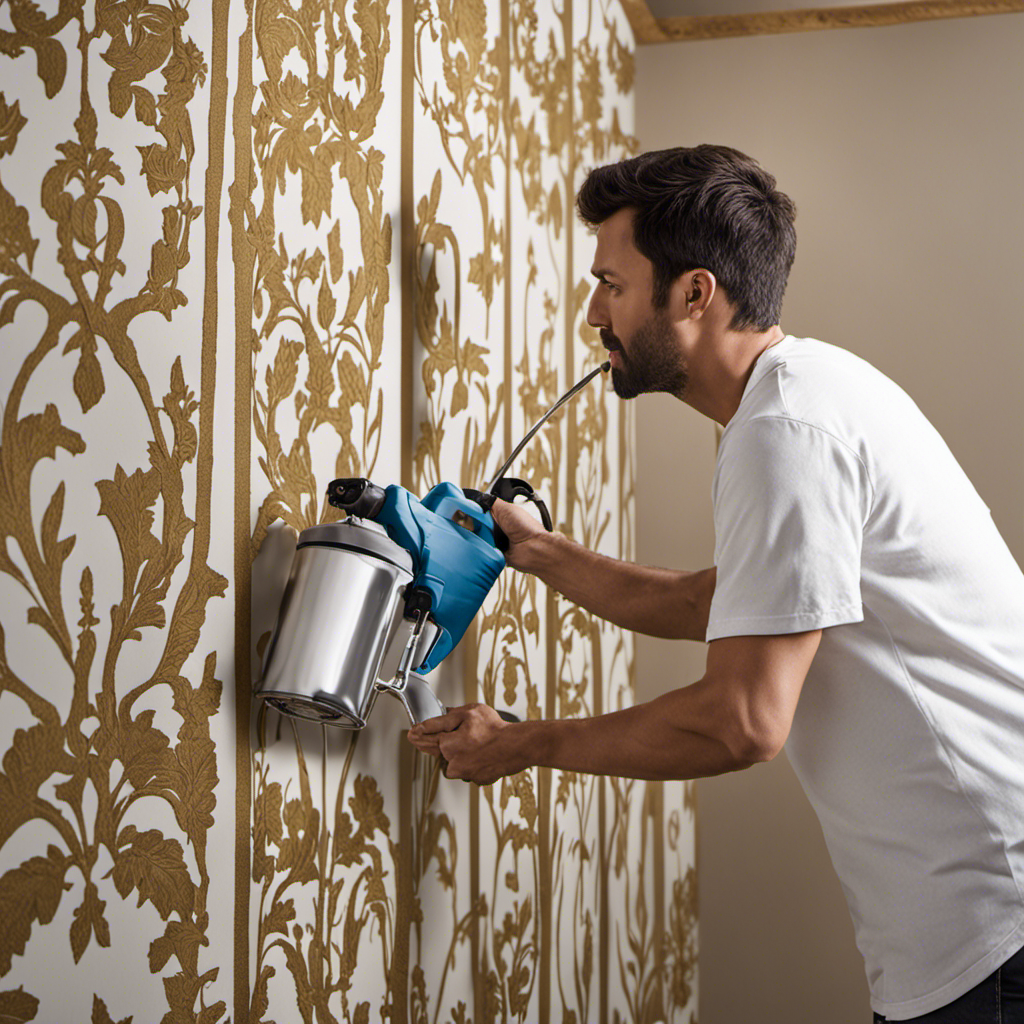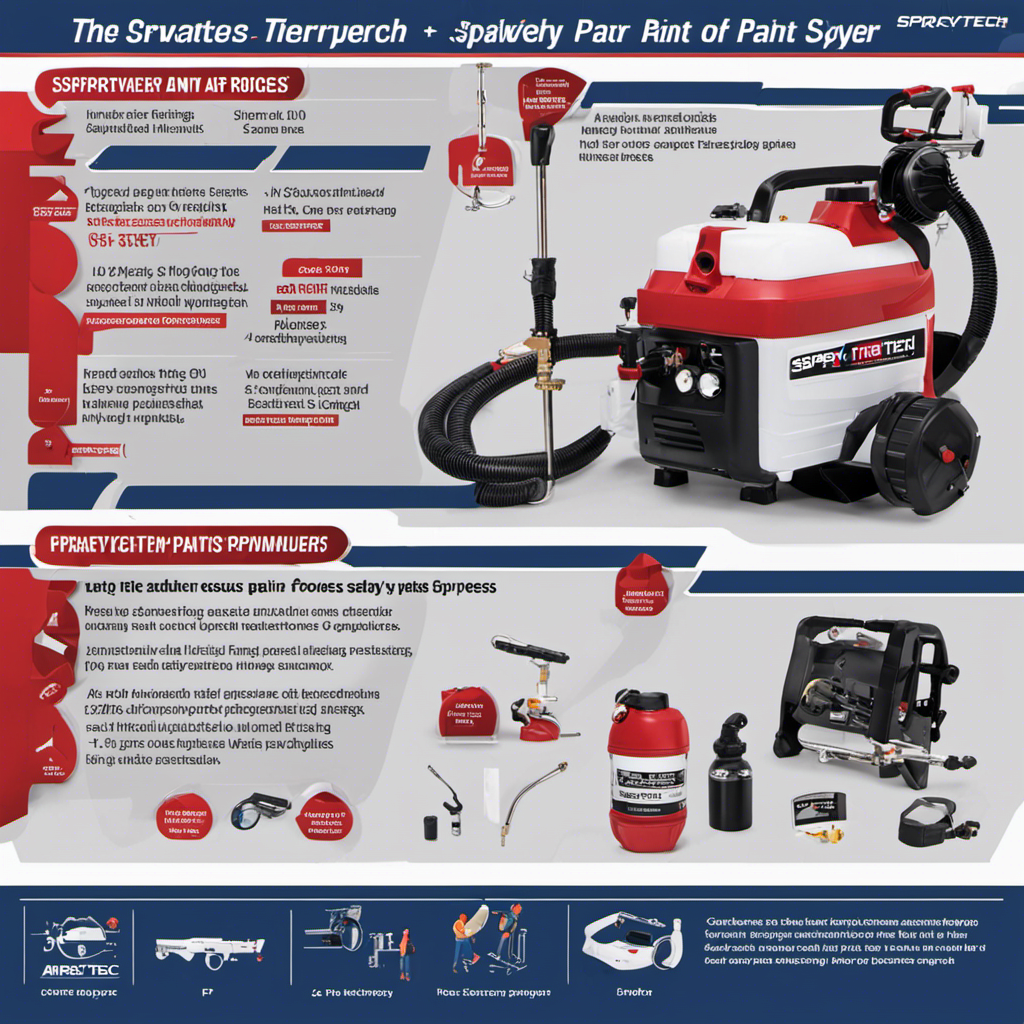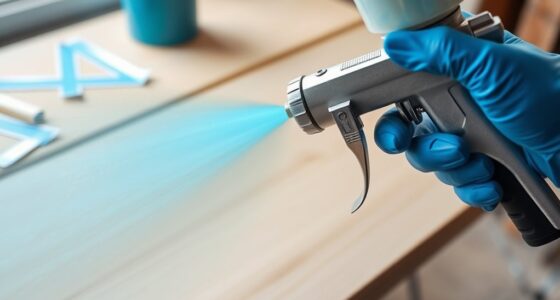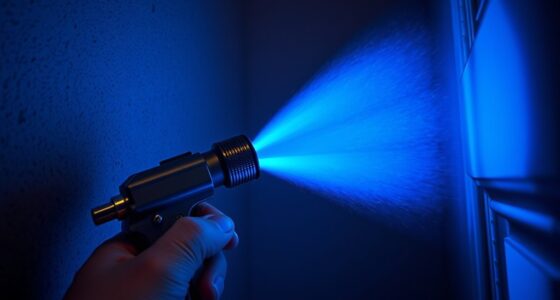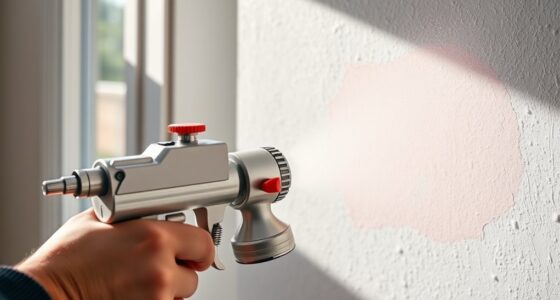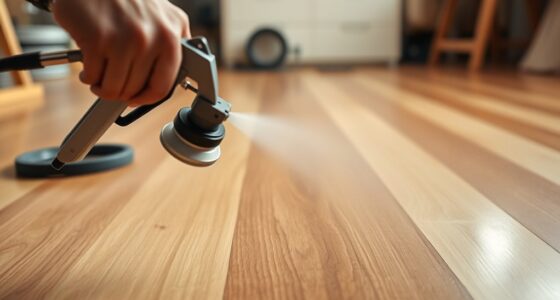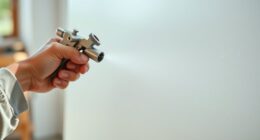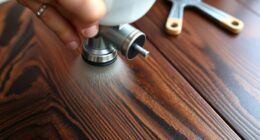When it comes to painting a house, some may find using an airless sprayer to be challenging. Nevertheless, mastering this method can lead to professional-quality results, while also speeding up and streamlining the painting process.
In this article, readers will discover step-by-step instructions on how to:
- Prepare the surface and equipment
- Choose the right paint color
- Set up and test the sprayer
- Achieve smooth and even coverage
- Address imperfections
- Ensure safety and environmental considerations.
With these valuable tips, anyone can become a pro at house painting with an airless sprayer.
Key Takeaways
- Proper surface preparation is crucial for a successful paint job with an airless sprayer.
- Using a high-quality airless sprayer can enhance the appearance and protect the house from the elements.
- Adjusting the pressure settings and spray pattern is essential for different surfaces and desired results.
- Regular maintenance and cleaning of the airless sprayer are necessary for optimal performance and longevity.
Preparing the Surface and Equipment
Using an airless sprayer enhances the appearance and protects the house from the elements. Before starting the painting process, it is crucial to prepare the surface and equipment.
Surface preparation is essential for achieving a smooth and long-lasting finish. This includes cleaning the surface to remove dirt, grease, and grime. It also involves removing loose paint and sanding rough areas. Using a primer, especially on porous or stained surfaces, is recommended to improve paint adhesion and durability.
By properly preparing the surface, you ensure that the paint adheres well and lasts for a longer time. Additionally, mastering the right painting techniques contributes to a professional-looking finish. This involves maintaining a consistent distance from the surface and using a smooth, steady motion.
Surface Cleaning and Paint Removal
The surface should be thoroughly cleaned and any loose paint should be removed before applying a fresh coat of paint. Surface preparation is crucial for achieving a professional-looking finish. Here are some effective paint removal techniques and surface cleaning steps:
| Surface Preparation | Paint Removal Techniques |
|---|---|
| Use a scraper or wire brush to remove loose paint or debris. | Sand rough areas or imperfections using medium-grit sandpaper. |
| Wash the surface with mild detergent and water to remove dirt, grease, and grime. | Use a heat gun or infrared paint remover to soften and scrape off old paint. |
| Allow the surface to dry completely before proceeding. | Apply paint stripper or chemical paint remover to dissolve and remove paint layers. |
| Consider using a primer, especially on porous or stained surfaces. | Pressure washing can be used for larger surface areas to remove paint. |
Importance of Primer and Paint Adhesion
Applying a primer before painting is essential for achieving optimal paint adhesion and durability. When using an airless sprayer, the benefits of using a primer are even more pronounced. Here are four reasons why using a primer with an airless sprayer is crucial:
-
Improved Paint Adhesion: The primer creates a strong bond between the surface and the paint, ensuring that it adheres properly and doesn’t peel or chip over time.
-
Enhanced Paint Durability: By providing a solid foundation, the primer helps the paint withstand the elements, such as harsh weather conditions and UV rays, resulting in a longer-lasting finish.
-
Increased Paint Longevity: With proper adhesion and durability, the paint will maintain its vibrant color and appearance for an extended period, reducing the need for frequent repainting.
-
Time and Cost Efficiency: Using a primer with an airless sprayer allows for faster and more efficient application, saving both time and money in the long run.
Proper Surface Sanding and Smoothing
To achieve a smooth finish, it is important for the painter to sand rough areas and imperfections on the surface before applying the primer and paint. Proper sanding techniques play a crucial role in achieving a professional-looking result. By using medium-grit sandpaper, the painter can smooth out any rough patches or imperfections on the surface, creating a clean and even canvas for the paint. Sanding helps to remove old paint, dirt, and debris, ensuring better adhesion of the primer and paint. It also helps to smooth out any uneven surfaces, resulting in a flawless finish. The table below outlines some key points to consider when sanding the surface:
| Proper Sanding Techniques |
|---|
| Use medium-grit sandpaper |
| Sand in a circular motion |
| Apply even pressure |
| Sand until the surface is smooth |
| Wipe away any dust or debris |
Choosing the Right Paint Color
Choosing the right paint color for your project can be a fun and creative process. It’s important to consider the overall aesthetic of your house and the desired mood or atmosphere of each room.
Here are some tips to help guide your decision-making process:
-
Understanding paint finishes: Different finishes have different characteristics and purposes. Matte finishes are ideal for hiding imperfections, while satin finishes offer a subtle sheen and are easy to clean. Semi-gloss and high-gloss finishes provide a more reflective surface and are great for high-traffic areas.
-
Color psychology: Colors can have a significant impact on mood and emotions. Warm colors like red, orange, and yellow can create a cozy and energetic atmosphere, while cool colors like blue and green promote calmness and relaxation. Consider the purpose of each room and choose colors accordingly.
-
Sample and test: Before committing to a color, it’s important to sample and test it on the walls. Colors can look different under different lighting conditions, so it’s best to see how they appear in the actual space. Paint small patches and observe them at different times of the day to make an informed decision.
-
Consultation and inspiration: If you’re unsure about which colors to choose, consider consulting with a professional or seeking inspiration from interior design magazines, websites, or social media platforms. Seeing how colors are used in real-life settings can help spark ideas and narrow down options.
Safety Measures and Protective Gear
Wearing goggles, gloves, and a respirator mask is essential for ensuring safety when using an airless sprayer. These protective gears shield the eyes, hands, and respiratory system from potential hazards such as paint particles and fumes.
In addition to wearing the proper gear, it is crucial to have proper ventilation in the painting area. Adequate ventilation helps to dissipate fumes and maintain a safe working environment. Opening windows and doors, using fans, or working in well-ventilated spaces are effective ways to achieve proper ventilation.
Selecting a High-Quality Airless Sprayer
A painter can ensure a professional and efficient painting process by selecting a high-quality airless sprayer that meets their specific needs and requirements. Here are four key factors to consider when choosing an airless sprayer:
-
Durability and reliability: Look for a sprayer made from high-quality materials that can withstand regular use and last for years to come.
-
Adjustable pressure and spray patterns: A versatile sprayer with adjustable settings allows for customization based on the surface being painted, ensuring optimal coverage and finish.
-
Easy maintenance: Choose a sprayer that is easy to clean and maintain. Regularly cleaning the sprayer after each use and addressing any issues promptly will prolong its lifespan and prevent common problems.
-
Customer reviews and reputation: Research different brands and models, read customer reviews, and consider the reputation of the manufacturer. This will give you insights into the performance and reliability of the sprayer.
Setting up and Testing the Sprayer
Inspecting the sprayer for any signs of damage or leaks is an important step in setting up and testing the airless sprayer. Proper sprayer maintenance ensures optimal performance and prevents potential issues during the painting process. To emphasize the importance of sprayer maintenance, here is a table highlighting common sprayer issues and troubleshooting solutions:
| Sprayer Issue | Troubleshooting Solution |
|---|---|
| Clogged nozzle | Clean or replace the nozzle |
| Inconsistent spray pattern | Adjust pressure settings or replace worn-out tip |
| Excessive overspray | Adjust spray pattern and pressure settings, or use a smaller tip |
| Leaking hose or fittings | Tighten connections or replace faulty parts |
| Loss of pressure | Check for clogs or blockages in the system, and adjust pressure settings accordingly |
Techniques for Smooth and Even Coverage
Using a smooth and steady motion, the painter moves the sprayer in overlapping passes to ensure even coverage of the surface. Achieving a flawless finish requires the right technique and attention to detail. Here are some tips for efficient paint coverage:
- Maintain a consistent distance from the surface being painted (12-18 inches).
- Move the sprayer in a smooth, steady motion, overlapping each pass by 50%.
- Adjust the spray pattern and pressure for different surfaces.
- Start and stop spraying off the surface to avoid buildup.
By following these tips, you can achieve a professional-looking finish with your airless sprayer.
Remember to be vigilant for drips or runs and address them promptly, as well as touch up any missed spots or thin areas.
With practice and patience, you can achieve a flawless result that will transform your space.
Addressing Imperfections and Touch-ups
To achieve a seamless finish, the painter meticulously addresses imperfections and performs touch-ups as necessary. Blending touch ups is an essential step in maintaining painted surfaces and ensuring a professional-looking result.
By carefully matching the paint color and texture, the painter can seamlessly blend any areas that require touch-ups, such as missed spots, thin areas, or minor imperfections. This attention to detail ensures that the painted surfaces appear uniform and flawless.
Additionally, maintaining painted surfaces is crucial for their longevity and appearance. Regular cleaning and inspection can help identify any peeling, cracking, or damage that may occur over time. By promptly addressing these issues and performing touch-ups as needed, the painter can preserve the beauty and integrity of the painted surfaces.
Safety and Environmental Considerations
Wearing the appropriate protective gear is essential to ensure the safety of the painter while operating the airless sprayer and working with paint. To prevent overspray and maintain equipment performance, here are four important considerations:
-
Adjust spray pattern and pressure settings: By carefully adjusting the spray pattern and pressure, painters can control the amount of paint being sprayed, reducing the risk of overspray and ensuring a more precise application.
-
Use masking tape and drop cloths: Protecting unwanted areas with masking tape and using drop cloths can help contain the paint and prevent it from spreading onto surfaces that should not be painted.
-
Maintain a consistent distance: Keeping a consistent distance from the surface being painted is crucial to achieving an even coat and minimizing overspray.
-
Regularly maintain equipment: It is important to regularly clean and inspect the airless sprayer to ensure optimal performance. This includes checking nozzle size, clearing any paint buildup, and addressing any signs of wear or damage.
Frequently Asked Questions
Can You Use an Airless Sprayer on Textured Surfaces?
Using an airless sprayer on textured surfaces can be a convenient method for painting uneven walls. It allows for efficient coverage and eliminates the need for brushes or rollers.
However, there are some pros and cons to consider. On the positive side, an airless sprayer can quickly apply paint to a large area, saving time and effort. However, it may not effectively reach all the crevices and grooves in heavily textured walls, resulting in uneven coverage.
Careful consideration of the texture and proper technique is necessary for the best results.
How Do You Choose the Right Size Tip for the Airless Sprayer?
Choosing the right size tip for an airless sprayer is crucial for achieving optimal paint coverage and avoiding common issues. To determine the appropriate tip size, consider the type of paint being used and the surface being painted. Thicker paints may require a larger tip size, while thinner paints may work well with a smaller tip size.
It’s also important to consult the manufacturer’s recommendations for the specific airless sprayer being used. Troubleshooting common issues with the sprayer, such as clogging or uneven spray patterns, may also involve adjusting the tip size.
What Is the Recommended Distance to Hold the Airless Sprayer From the Surface Being Painted?
The recommended distance to hold an airless sprayer from the surface being painted is typically 12-18 inches. This distance allows for an even and consistent application of paint. By maintaining this distance, the sprayer can effectively cover the surface without causing drips or runs.
It is important to adjust the spray pattern and pressure settings accordingly for different surfaces. Following this recommended distance will help achieve a professional-looking finish with the airless sprayer.
How Do You Clean the Airless Sprayer After Each Use?
After each use, cleaning the airless sprayer is essential for its maintenance and longevity. To ensure proper function, the cleaning process involves several steps.
First, disconnect the sprayer from the power source and release the pressure by triggering the gun. Remove the tip, filter, and hose, and clean them thoroughly with water or a cleaning solution.
Wipe down the exterior of the sprayer and store it in a clean, dry place.
Following these maintenance tips will help keep your airless sprayer in excellent condition for future use.
Are There Any Specific Techniques for Painting Windows and Trim With an Airless Sprayer?
When painting windows and trim with an airless sprayer, there are specific techniques that can help achieve a smooth finish.
First, ensure proper masking to protect surrounding areas.
Use a smaller tip size and lower pressure settings for more control.
Start with a light mist coat and gradually build up the paint layers, being careful not to overspray.
Take your time and maintain a consistent distance from the surface.
Follow these tips for professional-looking results on woodwork with an airless sprayer.
Conclusion
In conclusion, mastering house painting with an airless sprayer is a skill that can be achieved with proper preparation and technique. By following the guide provided, homeowners can ensure a smooth and professional-looking finish on their walls.
Remember, like a skilled artist with a brush, a homeowner armed with an airless sprayer can transform their living space into a masterpiece. So, don’t be afraid to take on the challenge and unleash your inner Picasso with the help of an airless sprayer.
Happy painting!
Franz came aboard the Paint Sprayer Zone team with a background in both journalism and home renovation. His articulate writing style, combined with a passion for DIY projects, makes him an invaluable asset. Franz has a knack for breaking down technical jargon into easy-to-understand content, ensuring that even the most novice of readers can grasp the complexities of paint sprayers.
